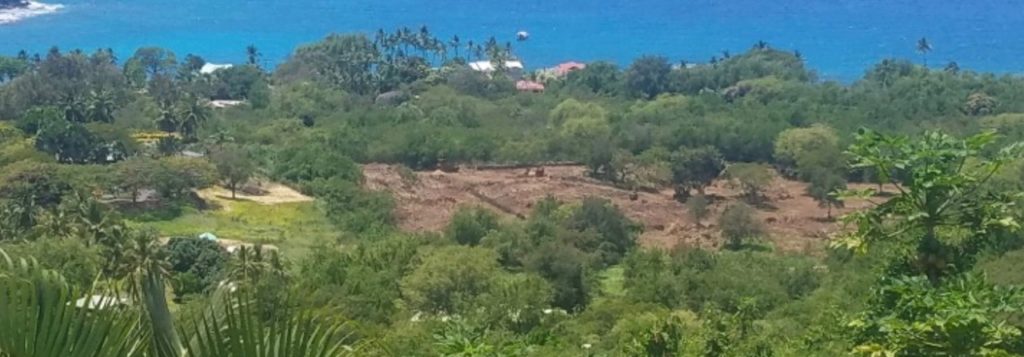Grading at Kealakekua: Within the last few weeks, extensive grading has occurred on a 73- acre parcel near Kealakekua Bay and adjacent to land that is part of the Kealakekua Bay State Historical Park.

Owner of the parcel is the Kealakekua Heritage Ranch, LLC, whose only member is Tom Pace. According to sources in the neighborhood, work began in mid-to late March.
On April 17, the Hawai‘i County Department of Public Works (DPW) ordered Pace to stop all grading on the property. Ben E. Ishii, chief of the department’s Engineering Division, wrote: “A search of our records shows that no grading or grubbing permits have been issued for this work. The grading work performed on the subject property is in violation of the Hawai‘i County Code.”
Ishii continued: “You are directed to cease any further work on the subject property,” and instructed the landowner to submit a grading permit application within 45 days.
“Approval of the application by the State Historic Preservation Division and the Planning Department are required prior to the approval and issuance [of a permit] by this department.”
Calls to the owner were not returned by press time.
The parcel, which is in the state Agricultural District and the county Agricultural Zone, was purchased by Kealakekua Heritage Ranch in 2017. Tax records show two existing houses on the property: one of about 1,700 square feet built in 1951, and another, of 600 square feet, built in 2018.
The latest notice is not the first Pace has re- ceived for unpermitted work on this property. In May of 2018, Pace was found to have been making improvements to his own driveway within the county right-of-way. On July 9, 2018, the DPW instructed him to obtain the required permit.
Last August, Pace workers appear to have de- stroyed the loading dock for the historic Gaspar coffee mill, dating back to the 1880s. The dock was transformed to rubble in a matter of days.
ROD Webinars: As with many events, the annual symposium on rapid ‘ohi‘a death has been cancelled. Organizers have, however, come up with a Zoom alternative.
Over a series of five Wednesdays, presentations will be given on the topics that otherwise would have been discussed at the symposium. The first two webinars, held in April, featured presentations on the distribution and abundance of rapid ‘ohi‘a death on Hawai‘i island and on the impact of rapid ‘ohi‘a death on forest stands.
On May 13, Kylle Roy and Robert Peck of the U.S. Geological Survey’s Pacific Ecosystems Research Center, will discuss the role of beetles in spreading the disease; on May 20, March Hughes of the USDA Forest Service’s Institute of Pacific Islands Forestry will talk about treatments for trees and wood; and on May 27, J.B. Friday, with the University of Hawai‘i’s Cooperative Extension Service, will present on actions that members of the public can take to manage the spread of rapid ‘ohi‘a death.
Each webinar will be given at noon and (live) again at 6 p.m., allowing people who may be working during the day to still be able to hear the presentations.
Details on joining the Zoom presentations are available at: https://cms.ctahr.hawaii.edu/rod/
Betsy Harrison Gagné: The death in March of Betsy Gagné cannot be allowed to go unremarked. For decades, Betsy was the conscience of the conservation community. In recent years, she was the glue that held together the state’s Natural Area Reserves System Commission, but that does not begin to describe the scope and importance of the work that she did to protect Hawai‘i’s unique ecosystems.
She educated. She scolded. She always was willing and eager to share her vast knowledge of Hawai‘i’s environment – and her views on those who threatened to harm it. And for this she was not universally loved.
In 1973, as a graduate student, Betsy was the first to come upon the po‘ouli. A year later, Betsy, her late husband, Wayne, and Frank Howarth came upon the bones of flightless birds in a cave near Hana, leading to a revolution in the understanding of island avifauna. Year after year, researchers and environmentalists alike benefited from her knowledge, curiosity, and energy.
Her passing leaves an unfillable void.
— Patricia Tummons

Leave a Reply